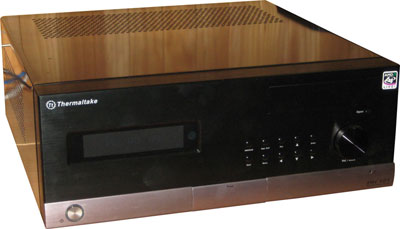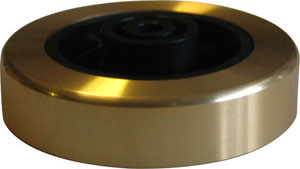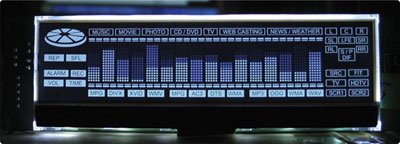Case, Testing, iMon, Usage
Case:
Every PC needs a case, and here we have a Thermaltake DH101 VF7001BNS. It’s black, shiny, and quite easy on the eye, in my completely subjective opinion.

The dual-tone brushed aluminium front is dominated by the 6” monochromatic LCD, which will get a more detailed investigation further on in this article. To the right we have an assortment of media control buttons, which seem slightly superfluous given the included remote control, and directly above that you can see the front facade of a recessed 5.25” drive bay, which is populated by a Pioneer Blu-Ray BD202MR.
On the bottom is a standard front connection panel which provides 2 USB, 1 FireWire, 3.5mm headphone and microphone connections. Not so standard is the nice spring-loaded action which gently lowers the covering bezel. The shiny brass feet for the case provide a nice finishing touch as well.

Testing:
Well, normally this is where we overclock a processor before putting it through a bunch of synthetic benchmarks, followed by some gaming and application tests. Fine and dandy for a new CPU or graphics card, but as this system is not really targeted for outright performance in the conventional sense, it seems misleading to tread the normal review path.
So, while I can share some power draw and CPU usage figures, the main focus will be trying to provide an insight into what the user experience is like, with regards to customisation and of course the main purpose of the system – media playback.
iMon:
Thermaltake’s “Media lab” solution, an included option on the review sample, encompasses the LCD on the front of the case, an infra-red remote, and iMon Manager software to help integrate it with Windows Media Centre.
The LCD has an impressive array of status indicators, which illuminate to represent your current playback selection (TV, DVD, music, etc.), current speaker setup, even the codec(s) in use. Smack bang in the middle of the almost befuddling array of lights, is the main bar of scrolling text, which can also double as a graphic equaliser if the user desires.

Image courtesy of SoundGraph, Inc.
Customising the scrolling text is a few clicks away, and allows the user to personalise it quite powerfully, with options such as font selection, scrolling speed, computer-specific statistics like CPU type & frequency, RAM statistics, network link speed, uptime, and more. These statistics are scrolled through sequentially whilst the machine is idle.
iMon’s software allows users to input RSS feeds for a news-headline scrolling mode, as well as local weather, an option to display new email, and finally an alarm function for those of you that like waking up to pounding industrial hardcore techno. I know you’re out there.
Viewing Content:

The remote’s navigational joystick was extremely touchy at default settings, but thankfully allows adjustment. Even with the adjustment, I think it’s still going to be something that users need a bit of time to get a “feel” for before they reach some sort of prowess.
It is possible to use it as a mouse, with right and left click buttons, but due to the touchiness I think most people will switch to the keyboard mode, where it acts as a keyboards arrow pad. Navigating through Windows Media Centre in this mode was practically effortless; anyone familiar with a hierarchical menu system will pick it up very quickly.
As you can see in the picture, the remote also features shortcut buttons for Music, TV, Pictures, DVD, and the standard stop, play, fast-forward and rewind media controls.
There is a button called app launcher which pops up a menu containing an easily customisable list of application shortcuts.

TV viewing was a breeze; you just pop up the mini TV guide and scroll through the channels until you find something you like. There is also a full-screen TV guide which can be accessed via Windows Media Centre’s menu. Recording is as simple as pressing record with a particular timeslot selected, and provides a handy option of how much over-run you would like to include to avoid missing a crucial ending.
DVD and Blu Ray viewing are indistinguishable from using a regular stand-alone player. Picture viewing isn’t exactly a revolution or a major technical achievement, but nevertheless it performs as one would expect, with slideshows featuring customisable cross-fades.
|


